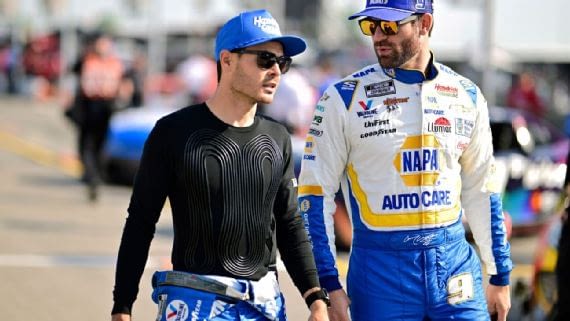The Cool Revolution: How Cooling Shirts Became a NASCAR Essential
May 8, 2025, 12:53 PM ET
It all began with a bit of intrigue: how did the cooling shirt make its way into the high-octane world of NASCAR? This question lingered in the minds of many, as some drivers were clueless about its origins, while others speculated that it must have been the brainchild of Hendrick Motorsports, or more specifically, the legendary Jimmie Johnson. Known for his forward-thinking approach to fitness and nutrition, Johnson seemed like the perfect candidate to introduce such a game-changing innovation.
As it turns out, Johnson was indeed the first driver to don the cooling shirt, but the real mastermind behind its introduction was his crew chief, Chad Knaus. Johnson recalls, “I was the first driver to wear one, but the guy who started it was Chad Knaus.” Knaus, always on the lookout for new technology and a holistic approach to performance, saw the potential in the cooling shirt, especially for Johnson, who often struggled with cramping and heat issues.
Johnson shares a vivid memory of Knaus’s unconventional testing method: “When we used to paint the cars, one of the bays would be to roll the car in and they would make it 100 degrees in there to hurry up and cure the paint. [Knaus] literally had one of our guys go in there with this damn shirt on, plug it in the wall and sit in there and test it by pretending he was in a race car. I’ll never forget Chad calling me, ‘You won’t believe it, this cool shirt thing works! I’ve got so-and-so in the spray bake booth, and I’m cooking him in there, and he’s got the shirt on, and it feels great!'”
Johnson began wearing the shirt around 2018 or 2019, initially keeping it a secret from his competitors to maintain his edge. However, as word spread, other drivers quickly followed suit, eager to experience the benefits for themselves.
Reigning NASCAR Cup Series champion Joey Logano describes the sensation with his trademark smile and laugh: “It’s like jumping in a pool on a hot summer day. It feels great. It’s awesome.”
So, what exactly is this revolutionary piece of gear? In simple terms, it’s a shirt equipped with cooling technology, featuring tubes through which cold fluids circulate. This innovation has transformed driver comfort, as Erik Jones explains, “I think back years ago when we did ice packs in our suits and threw them out between stops. The endurance side, on a hot day, it’s just a game changer. There were days when you’d get out of those hot races and you were done and wiped out, even as much as you trained or didn’t train. So, this has changed it to where if it’s a 90-degree day, I don’t think anyone is worried about the heat in the car anymore.”
Over the years, driver comfort has evolved significantly. Ice packs, fans, and the helmet hose, which still blows cool air on the driver’s head, were once the go-to methods for keeping temperatures down. However, the cooling shirt has become the preferred choice due to its comprehensive coverage. Today, it’s rare to find a driver not wearing one.
Jones isn’t the only one to call the cooling shirt a “game changer.” Michael McDowell notes that the rise in popularity of these shirts coincided with the introduction of the Next Gen car in 2022. Teams quickly realized how much hotter these cars were, making the cooling shirts even more appealing.
McDowell explains, “[The shirts] were around, but they would fail often, or they wouldn’t be that cold. You would be worried to run them because you didn’t know if it would be a good or a bad day for it, but now, I know there are still some troubles every now and then, but phew, it’s unbelievable how much that helps keep your core cool, your vital organs cool, and just lowering your heart rate from taking some of that heat out is a big deal.”
Some drivers, like Shane van Gisbergen, even take it a step further by freezing their shirts beforehand. His PR representative has a standing reminder to “put cool shirt in freezer an hour and a half before the drivers’ meeting” in her personal calendar.
Not every driver wears the shirt every weekend, as the decision often depends on the weather. Ross Chastain is one such driver, noting that there are times when he prefers to sweat. “Martinsville, I had to use the bathroom because I wasn’t sweating enough,” he admits.
When in use, the shirt (or vest, depending on preference) connects to a pump under the firesuit. As Kyle Larson‘s interior specialist, Cesar Villanueva, explains, the pump can be mounted anywhere. It cycles through water and a mixture of antibacterial and antifungal fluid to keep the system clean. If the fluid isn’t cycled, it can clog, causing the pump to fail. However, there are other reasons a system might fail during a race.
Austin Dillon describes the predicament of a system failure: “You’re just trapped in a bad situation. There is nothing you can really do about it but shut it off, and you can dump the water out if you have to, but it’s kind of like a lifeline. It’s pretty important to have.”
When the system fails, drivers begin to overheat, as the fluids become hot with no way to escape. Logano sums it up: “It’s great until it’s not. But more times than not, it’s great. Honestly, they’ve done a good job developing that whole system. It used to be really heavy, which is why no one used it, and now you have a process where it’s pretty efficient to run, and if it can mentally help you at the end of a race because you’re physically fresher, you do it.”
Weight is a significant consideration, as driver comfort must be balanced with car performance. The cooling unit adds about 6½ to 7 pounds, which can impact lap times. However, as Chris Buescher points out, “I think we’ve accepted some of the weight penalty in wearing it because you have to make sure you’re as fresh as possible to fight at the end of these races.”
Tyler Reddick began using a cooling shirt in 2021 after losing weight, realizing he needed something to regulate his core temperature better. He praises the shirt, saying, “A lot of drivers use it. I think what it does for cooling the body is probably the most efficient thing that we have.”
Originally Written by: Kelly Crandall




















